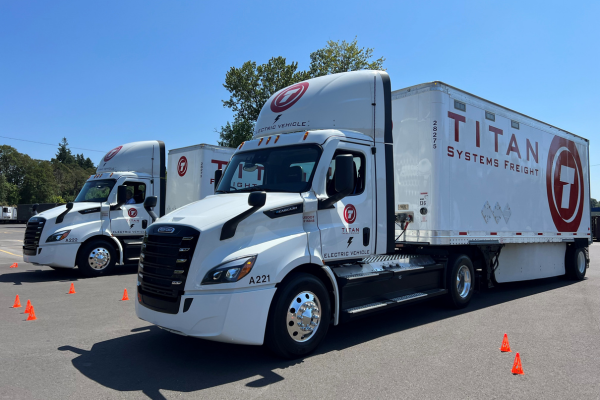Oregon is committed to having a transportation sector free of tailpipe pollution by 2040. To make that happen, we must address how we move freight across our state. Revving up the adoption of zero-emission vehicles (ZEVs) is crucial for achieving these climate and air quality goals. Surprisingly, 42% of all vehicle emissions come from medium and heavy-duty (MHD) vehicles, and just over half of the counties in Oregon have air quality rated as harmful due to diesel exhaust.
There’s no way around it; we cannot meet our air quality and climate goals without retiring the existing fleet of diesel-powered medium- and heavy-duty trucks. Zero-emission electric trucks are available right now, and they can directly replace diesel vehicles to keep our economy moving.
Addressing Concerns:
Can electric trucks actually go far enough and carry loads like current trucks?
Yes! While you might think of trucks as going hundreds, if not thousands, of miles on their routes, research from the Rocky Mountain Institute has found that 45% of Oregon trucks could be electrified now based on their routes and total drive distance. The distances will only go up as technology and logistics for electric trucks improve.
But where are we going to charge them?
While it's true that the current infrastructure needs significant expansion, we are also in a moment of MASSIVE public and private investments into charging infrastructure, to the tune of $30 billion across the US. There’s work to be done to speed up the timeline in getting these large chargers up and running. Still, trucking companies can and should expect more charging capacity to come online, especially since Oregon just received additional funding from the EPA’s record-breaking climate pollution reduction grant.
Do we have enough power?
Oregon is also planning ahead, requiring utilities to plan for this increase in energy demand from vehicle electrification and create solutions that can allow us to meet our energy needs. The same Rocky Mountain Institute study found that if we electrified all the trucks that can be electrified now in the next three years, it would only represent an increase of about 3% of Oregon’s current power demand (1.5MWh). For scale, demand from data centers and AI are likely to be orders of magnitude larger by 2029, as much as five to ten times the average power consumption of the city of Portland.
How can we afford electric trucks?
While electric trucks have higher upfront costs, their total cost of ownership is often lower due to reduced fuel and maintenance expenses. The Environmental Defense Fund found cost parity with diesel trucks within three years, sometimes almost immediately. Oregon's coordinated efforts with California and Washington state create a consistent West Coast market, driving down costs through economies of scale.
The Transition has already begun!
Oregon is taking essential steps to eliminate climate pollution from medium—and heavy-duty trucks, which have an outsized impact on climate change and human health. It is poised to be a leader in the generation of clean power, the adoption of large zero-emission vehicles, and even the manufacturing of zero-emission trucks.
The Advanced Clean Truck (ACT) and Advanced Clean Fleet (ACF) rules ensure a gradual transition. Starting in 2024, the ACT rule requires increasing sales of zero-emission trucks, aiming for 50-75% of new trucks to be zero-emission by 2035. The ACF rule mandates fleet operators to transition to zero-emission vehicles by 2045. This phased approach ensures a smooth shift to electrification.
Looking ahead, Oregon’s Medium and Heavy-Duty Rebate Program will offer rebates for electric trucks. Reliable funding will support Oregon's climate goals and ensure equitable access to clean transportation. Climate Solutions and our coalition partners are already organizing to ensure the state’s 2025 transportation package contains investments that will keep us on track with our clean air and climate goals. Stay tuned for more ways to get involved!





